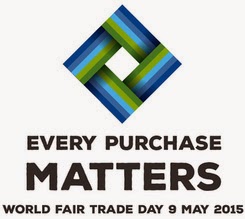"If you look at Kiva.org, people with a very modest amount of money can make a huge positive impact all around the world"
- President Bill Clinton
One of the major themes of Fashion Revolution Day has been the disconnect between consumers and makers of fashion. The more we reconnect the links, the closer we come to a fairer future. That's why I was excited to hear from Brianna who works at Kiva - the world's largest micro-lending platform. Micro-finance is a term used to describe financial services to low-income individuals or to those who do not have access to typical banking services. It's also the idea that low-income individuals are capable of lifting themselves out of poverty if given access to financial services. Importantly, Kiva is a nonprofit organization and makes no money from the loans they facilitate.
Brianna explained to me that Kiva believes in ethical and eco-friendly business practices, greater transparency and fairer working conditions in the fashion industry. You can read about their own involvement in Fashion Revolution Day here.
Having discovered Kindness by Design, Brianna realised that my passionate reader's would surely be interested in a simple yet powerful way to impact the makers of fashion. I agreed!
The way it works is pretty simple:
100% of every dollar you lend on Kiva goes directly towards funding loans; Kiva does not take a cut and does not charge interest to their Field Partners, who administer the loans. Click here to read about the lending process in more depth.
So what kinds of positive change are you enabling through your loan? Let me introduce you to Pamela.
Pamela is one of Kiva’s artisan borrowers from Kibera, Nairobi. When the single mother of four found out she was HIV positive, she started treatment for HIV and founded a support group for recently diagnosed women called the Kibera HIV/AIDS Support Initiative Program. She also taught herself to bead and now owns her own jewelry shop, which donates 50% of its profits back to newly diagnosed women in the group.
With a loan from Kiva, Pamela was able to expand the types of goods she offers in her shop. In 2012, the average annual income per capita in Kenya was less than $950. Pamela now makes an average of $2,100 per year. Pamela is a shining example of how a Kiva loan, partnered with hard work, dedication and belief in a better future, can empower artisans around the world. When I searched under the category 'clothing' today on Kiva, I found 300 loans available!
There are a number of other ways to support Kiva's vision of connecting people and alleviating poverty. You can join with other lenders to achieve larger goals, ask your wedding or birthday guests to donate funds, become a Kiva Fellow abroad and much more.
You can connect with Kiva via Facebook and Twitter.
Have you had experience with a Kiva loan or other micro-lending program? I'd love to hear about it in the comments below :-)
 Disclaimer: This is not a paid post. Reviews cannot be purchased and submitting a product/service does not guarantee a favourable review. The opinions are 100% the author's own.
Disclaimer: This is not a paid post. Reviews cannot be purchased and submitting a product/service does not guarantee a favourable review. The opinions are 100% the author's own.



















